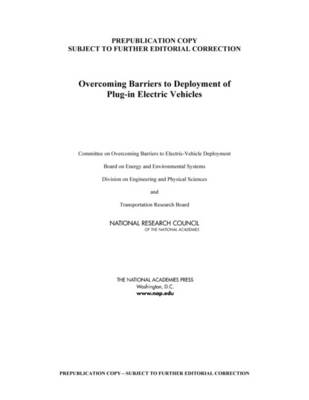
In the past few years, interest in plug-in electric vehicles (PEVs) has grown. Advances in battery and other technologies, new federal standards for carbon-dioxide emissions and fuel economy, state zero-emission-vehicle requirements, and the current administration's goal of putting millions of alternative-fuel vehicles on the road have all highlighted PEVs as a transportation alternative. Consumers are also beginning to recognize the advantages of PEVs over conventional vehicles, such as lower operating costs, smoother operation, and better acceleration; the ability to fuel up at home; and zero tailpipe emissions when the vehicle operates solely on its battery. There are, however, barriers to PEV deployment, including the vehicle cost, the short all-electric driving range, the long battery charging time, uncertainties about battery life, the few choices of vehicle models, and the need for a charging infrastructure to support PEVs. What should industry do to improve the performance of PEVs and make them more attractive to consumers? At the request of Congress, Overcoming Barriers to Deployment of Plug-in Electric Vehicles identifies barriers to the introduction of electric vehicles and recommends ways to mitigate these barriers. This report examines the characteristics and capabilities of electric vehicle technologies, such as cost, performance, range, safety, and durability, and assesses how these factors might create barriers to widespread deployment. Overcoming Barriers to Deployment of Plug-in Electric Vehicles provides an overview of the current status of PEVs and makes recommendations to spur the industry and increase the attractiveness of this promising technology for consumers. Through consideration of consumer behaviors, tax incentives, business models, incentive programs, and infrastructure needs, this book studies the state of the industry and makes recommendations to further its development and acceptance. Table of Contents Front Matter Summary 1 Introduction 2 Plug-in Electric Vehicles and Charging Technologies 3 Understanding the Customer Purchase and Market Development Process for Plug-in Electric Vehicles 4 Government Support for Deployment of Plug-in Electric Vehicles 5 Charging Infrastructure for Plug-in Electric Vehicles 6 Implications of Plug-in Electric Vehicles for the Electricity Sector 7 Incentives for the Deployment of Plug-in Electric Vehicles Appendixes Appendix A: Biographical Information on the Committee on Overcoming Barriers to Electric-Vehicle Deployment Appendix B: Meetings and Presentations Appendix C: International Incentives
| ISBN: | 9780309372176 |
| Publication date: | 26th July 2015 |
| Author: | National Research Council, Transportation Research Board, Division on Engineering and Physical Sciences, Board on Energy and Envir |
| Publisher: | National Academies Press |
| Format: | Paperback |
| Pagination: | 152 pages |
| Genres: |
Transport industries |